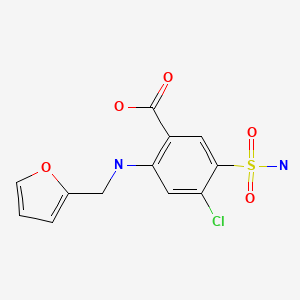Attribution Statement: LactMed is a registered trademark of the U.S. Department of Health and Human Services.
NCBI Bookshelf. A service of the National Library of Medicine, National Institutes of Health.
Drugs and Lactation Database (LactMed®) [Internet]. Bethesda (MD): National Institute of Child Health and Human Development; 2006-.
CASRN: 54-31-9

Drug Levels and Effects
Summary of Use during Lactation
Because little information is available on the use of furosemide during breastfeeding and because intense diuresis from high doses might decrease lactation, an alternate drug may be preferred, especially while nursing a newborn or preterm infant. Low doses of furosemide (20 mg daily) do not suppress lactation.
Drug Levels
Maternal Levels. Relevant published information was not found as of the revision date.
Infant Levels. Relevant published information was not found as of the revision date.
Effects in Breastfed Infants
Anecdotal, short-term observations at one medical center found no adverse infant effects from maternal use of furosemide in the immediate postpartum period.[1]
Effects on Lactation and Breastmilk
Furosemide 20 mg intramuscularly on the first postpartum day followed by 40 mg orally for 4 days has been used in conjunction with fluid restriction and breast binding to suppress lactation within 3 days postpartum.[2] The added contribution of furosemide to fluid restriction and breast binding, which are effective in suppressing lactation, is not known. No data exist on the effects of loop diuretics on established lactation.
A randomized, controlled trial compared postpartum furosemide (n = 192) to placebo (n = 192) in women who had gestational hypertension and preeclampsia. Patients received either a 4- to 5-day course of 20 mg oral furosemide daily or placebo. The first dose was given 6 to 24 hours postpartum and then every 24 hours thereafter until hospital discharge. No difference was found in patient-reported breastfeeding difficulties between the two groups.[3]
Alternate Drugs to Consider
References
- 1.
- Font LM. Breast milk and drugs. MCN Am J Matern Child Nurs 1989;14:308-9. Letter. PMID: 2507852. [PubMed: 2507852]
- 2.
- Cominos DC, Van Der Walt A, Van Rooyen AJ. Suppression of postpartum lactation with furosemide. S Afr Med J 1976;50:251-2. PMID: 3858. [PubMed: 3858]
- 3.
- Lopes Perdigao J, Lewey J, Hirshberg A, et al. Furosemide for accelerated recovery of blood pressure postpartum in women with a hypertensive disorder of pregnancy: A randomized controlled trial. Hypertension. 2021;77:1517–24. [PMC free article: PMC8099047] [PubMed: 33550824]
Substance Identification
Substance Name
Furosemide
CAS Registry Number
54-31-9
Disclaimer: Information presented in this database is not meant as a substitute for professional judgment. You should consult your healthcare provider for breastfeeding advice related to your particular situation. The U.S. government does not warrant or assume any liability or responsibility for the accuracy or completeness of the information on this Site.
- User and Medical Advice Disclaimer
- Drugs and Lactation Database (LactMed) - Record Format
- LactMed - Database Creation and Peer Review Process
- Fact Sheet. Drugs and Lactation Database (LactMed)
- Drugs and Lactation Database (LactMed) - Glossary
- LactMed Selected References
- Drugs and Lactation Database (LactMed) - About Dietary Supplements
- Breastfeeding Links
- PMCPubMed Central citations
- PubChem SubstanceRelated PubChem Substances
- PubMedLinks to PubMed
- Toxicology and Carcinogenesis Studies of Furosemide (CAS No. 54-31-9) in F344/N Rats and B6C3F1 Mice (Feed Studies).[Natl Toxicol Program Tech Rep ...]Toxicology and Carcinogenesis Studies of Furosemide (CAS No. 54-31-9) in F344/N Rats and B6C3F1 Mice (Feed Studies).National Toxicology Program. Natl Toxicol Program Tech Rep Ser. 1989 May; 356:1-190.
- Review Indapamide.[Drugs and Lactation Database (...]Review Indapamide.. Drugs and Lactation Database (LactMed®). 2006
- Review Bumetanide.[Drugs and Lactation Database (...]Review Bumetanide.. Drugs and Lactation Database (LactMed®). 2006
- Review Hydrochlorothiazide.[Drugs and Lactation Database (...]Review Hydrochlorothiazide.. Drugs and Lactation Database (LactMed®). 2006
- Review Triamterene.[Drugs and Lactation Database (...]Review Triamterene.. Drugs and Lactation Database (LactMed®). 2006
- Furosemide - Drugs and Lactation Database (LactMed®)Furosemide - Drugs and Lactation Database (LactMed®)
Your browsing activity is empty.
Activity recording is turned off.
See more...
